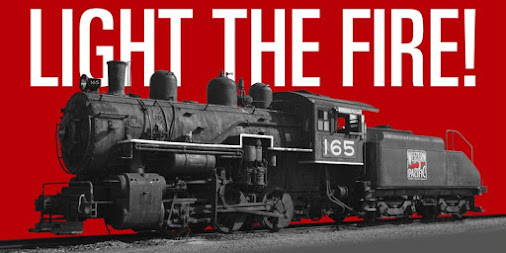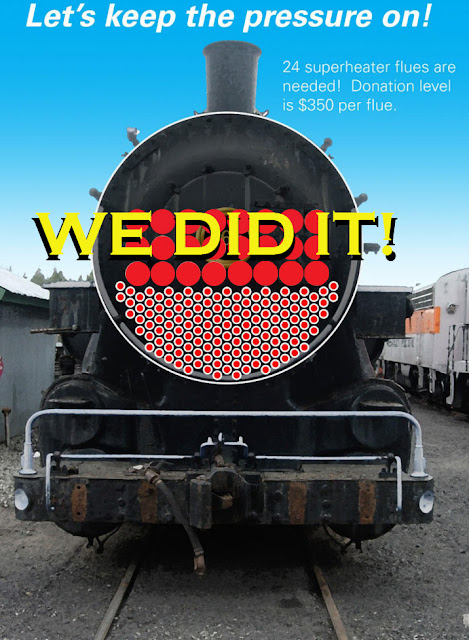To Preface: A great deal of preparation went into getting
ready for the Spring 2013 work session. Lots of folks, including Roger Stabler,
Rod McClure, Steve Habeck, Charlie Spikes, James Mason, Susan Scarlett, Rick
Gruninger, and Severn Edmonds went above and beyond to make sure things went
smoothly. I am very appreciative for their efforts.
I made good my escape from the Greater Los Angeles area
early on the morning of Tuesday April 16th. A fierce headwind driving up the
valley gave me some idea of what lie ahead.
A midday stop in Sacramento at our spring re-builder to load six rejuvenated
leaf springs left my truck somewhat lower to the ground. I handed off his
payment, which was substantial, and it was off to lunch with Steam Team member
Dick Coudin and Paul Zaborsky, Railway Manager at WRM. Temperature at sea level
was in the low 80’s, but the clouds hanging over Donner remained ominous.
With around 1000+ pounds of spring steel in the bed of the
truck, my power steering seemed to be a lot more powerful. A few snow flurries up ahead, but thankfully
no chain controls were being enforced.
Winter was in full force by the time I made Beckworth, not being able to
see more than twenty feet in front of my hood. I was able to make out the
crossing gates on Road A23 ahead, and aimed straight for them. Being raised in
Southern California, I don’t get into violent snow storms too often, and the
remainder of the trip into Portola was dicey to say the least. I pulled through
the gate, the sun immediately came out, and I was greeted by the familiar sound
of a Fairbanks-Morse prime mover thumping off in the distance.
Wednesday morning, the first order of business was to wash
the sandblast media out of the mudring. Joined by boilermaker Norman Comer,
Charlie Spikes, Dave Anderson and Kirk Baer, we used a variety of means to
clean out the black sand. Temperatures were still in the high 30s, it took a
while for Charlie to thaw out the pump on the water trailer, and I managed to thoroughly
soak myself to the bone, but by lunch the mudring was cleared out.
Kudos goes to Kirk Baer and Dave Anderson who got the
locomotive frame needlescaled and primered prior to our work session. The locomotive looks great, as do the drivers
that were painstakingly cleaned up by Dick Coudin and others, who stuck with it
until the end. Great job guys!
Two full weeks at Portola was my longest stay to date, and
the days tended to flow into one another. I can say that a great deal of extra
work on the boiler was accomplished by Norman, and later in the session by
Roger. The rear tube sheet that the late Dana Greeley started cleaning up six
years ago was finally finished by Norman after three arduous days of grinding
and pounding. Just about everyone on the crew had a hand in this unsavory job
and ate more than a little grit in the firebox, but now we are onto other things.
Another tube sheet patch is indicated, this time in the upper knuckle of the
rear sheet, an area that was badly cracked, and badly repaired by the previous
owner. Dave Varley, who is generously
generating our FRA Form 4, a document which calculates the stresses on various
parts of the boiler, identified a few more spots to take a closer look at this summer.
Thanks go to Nathan Osborn, who spent a few days taking more ultrasound
readings to relay to Dave Varley for use in the Form 4. This is another task
that is seemingly unending, but Nathan has stuck with it.
Norman and I spent two full days getting the spring rigging
set up, no small feat given that our white forklift was down. The “new” springs
had a good deal more arch to them which made getting them back into their old
positions a bit of a challenge. The porta-power was up to this Herculean task,
and everything went back where it belonged. We were joined by Severn Edmonds
from GGRM, and our own Hank Stiles by now, and we were off to the races.
 |
| REBUILT SPRINGS FINALLY IN PLACE. |
Severn spent time cleaning up the shoes and wedges for the pedestal jaws, and Hank started to polish up the journals on the driver
axles. These jobs can prove to be somewhat repetitive, but at times like this
we are glad the engine is an 0-6-0, and not a 2-10-4. Severn drilled each shoe
for a set-bolt, a clever way to keep it in place on the frame while being set
on the drivers. I suppose this SP trick would have been used by the WP as well
if they had thought of it. All the while Steve Habeck, helped by Greg, Matt and
Dave Elems had been switching things around so that the tender could be
positioned for removal of the oil and water cisterns at the lift site. They
also cleared up the shop track so we could position the driver sets outside and
put up the side rods prior to the pick. A lot of thought goes into these switch
moves, especially given how crowded our yard is, and we really appreciate it.
 |
| Dave, Steve, and Charlie on the forklift put side rods on. |
 |
| Driving boxes go on- thanks to Hank for his handy lifting rig. |
An evening in the lounge car “Silver Debris” and a viewing
of Blazing Saddles helped to clear our heads as well as provide a bit of
perspective on things. A nice little treat for all…
Fast forward to lift day, suffice to say a great deal took
place on all fronts prior, but the focus of our work was to get the 165 rolling
again, and that day was now at hand.
On Friday the 26th, two 75 ton capacity hydraulic rigs from
Bragg Crane in Reno arrived right on time. Given the current state of our 200
ton WP derrick, I made the decision that we would go with the sure thing. That
decision proved to work out, as the lift went quite smoothly. Steve Lee was
assigned the job of lift-master, the only person allowed to give signals to the
cranes, just to keep confusion to a minimum. Four of us also donned the
hardhats and went around with bars to move driving boxes this way and that to
get everything in alignment. After about 40 minutes the frame and boiler were
reunited with the driver sets, and it was onto the tender. The oil tank had been
previously removed the day before using the big rental forklift, so all that
remained was to remove the water cistern and place it on blocks for
sandblasting this summer. The foot valves in the front were a bit of a problem,
but Roger cut the holes in the steel decking a bit larger, and we prevailed.
| Roger in the boiler, removing rivets in the rear tube sheet knuckle. |
| Dave Varley, GGRM Chief Mechanical Officer, pouring over stress calculations for the 165 boiler. |
Engine and tender (frame) were reunited for the first time
in many years, and the switch crew pushed us into the shop, a good feeling after
weeks of work, done safely and professionally by all involved.
Erin Swain, life member from Flagstaff, Arizona, was all the
while patching holes in the roof of the locomotive’s cab, and they were
numerous. He managed to get his project just about done, including driving
rivets in concert with Kirk who also helped to grind welds. Erin will start
milling the wood for the cab interior soon, which will look great no doubt.
Thanks to him for seeing this portion of the project through!
| Up we go! |
| Lift master Steve Lee with a re-wheeled locomotive. |
| Back indoors after two years. |
| Severn and Roger take a break from setting wedges and binders. |
The GGRM boys along with Hank and Roger started the arduous
task of placing the wedges and pedestal binders back up into place, which took
all day, and was finished up on Sunday by Severn. A great deal of effort was expended by all,
but the goal at hand was in site, and we reached it just in time for a delicious
meal expertly prepared by Gail McClure that included Tri-tip, chicken and all
the sides, and two tasty cakes for dessert. Thanks to Gail for such a great
meal!
This was our biggest and most complicated work session to
date, and I expect there will be more like it as we get closer to
steam-up. Thanks to everyone who pitched
in, gave up their time to help the project along. I appreciate it greatly as
does everyone in the Feather River Rail Society. Those in attendance included: Hank Stiles,
Charlie Spikes, Steve Lee, Roger Stabler, Kirk Baer, Dave Anderson, Matt
Parker, Dick Coudin, Erin Swain, Severn Edmonds, Garrett Brisbie, Jim
Prettyleaf, Nathan Osborn, Dave Roth, Dave Hensarling, Dave Varley, Jeff Boone,
Deanna Knowles, Nancy Harding, Ken Asmus, new volunteer Mike (sorry didn’t catch
your last name!), Bob Sims, and a few others which I am omitting to be sure,
for which I apologize. I missed a few of you thanks to the “Fog of War”
atmosphere that hangs over the chaos and general confusion these events
generate.
| Charlie begins to clean up the tender frame decking. |
 |
| Group photo Saturday night. Yes there are wheels behind all the folks. Thanks to Eugene Vicknair for this photo. |
Next summer the work dates will be Thursday July 18 through Saturday
the 20th. This is usually our lightest work session as far as patronage is
concerned; come out and help if you can. Our focus will now be on getting
the boiler buttoned up for its hydro test. I would like to accomplish this by
the end of the year, but it may take longer. I set realistic goals for the project, but I
also have to take into account that life sometimes gets in the way.
Thanks again to everyone for your help, as well as to our
members and friends who graciously continue to provide financial and moral
support. I look forward to our next outing together! Thanks also to Dick Coudin for many of the photos used here. More can be view in his 165 gallery. Look for some video to be
posted soon, thanks to Bob Sims. Now for a nap…- JCA





